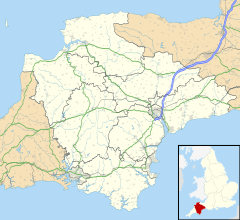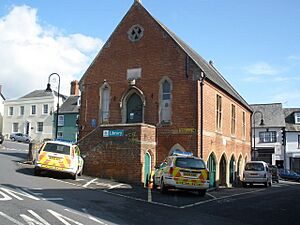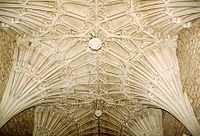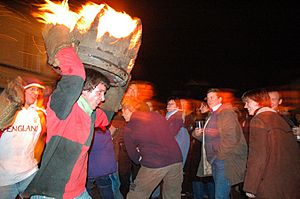Ottery St Mary facts for kids
Quick facts for kids Ottery St Mary |
|
|---|---|
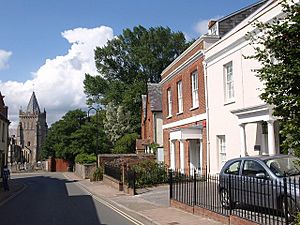 Paternoster Row |
|
| Population | 4,898 (2011) |
| OS grid reference | SY0995 |
| Civil parish |
|
| District |
|
| Shire county | |
| Region | |
| Country | England |
| Sovereign state | United Kingdom |
| Post town | OTTERY ST. MARY |
| Postcode district | EX11 |
| Dialling code | 01404 |
| Police | Devon and Cornwall |
| Fire | Devon and Somerset |
| Ambulance | South Western |
| EU Parliament | South West England |
| UK Parliament |
|
Ottery St Mary, often called "Ottery", is a town in Devon, England. It is located in the East Devon area, right by the River Otter. The town is about 10 miles (16 km) east of Exeter.
In 2011, the town itself had a population of 4,898 people. The wider parish, which includes nearby villages like Fairmile and Tipton St John, had a population of 7,692 in 2001.
Ottery St Mary has many local shops, especially on Mill Street, Silver Street, and Yonder Street. 'The Square' is the main part of the town. You can find pubs, restaurants, and cafes there. The town offers many services and shopping options for people living nearby and for visitors.
Contents
Understanding Ottery's Name
The name Ottery first appeared in a very old book called the Domesday Book in 1086. It was written as 'Otri' or 'Otrei'. The full name 'Oteri Sancte Marie' was first used in 1242.
The town gets its name from the River Otter. This river was named after the animal, the European otter. The "St Mary" part was added because the town belonged to the church of St Mary in Rouen, France, back in 1086.
There's also a place nearby called Chettisholt. This name is special because it comes from an old language called Common Brittonic. The first part of the name means "wood" in that language. The second part, 'holt', means "wood" in Old English. It was added later when people forgot the original meaning.
A Look at Ottery's Past
In 2014, during building work, archaeologists found an old medieval longhouse. It was built between 1250 and 1350 AD.
Ottery has some important old buildings. These include the Tumbling Weir and the famous St Mary's Church. The town is also home to The King's School. This school was started by King Henry VIII in 1545. It used to be a grammar school but is now a comprehensive school. Ottery St Mary Primary School is also in the town.
The Old Town Hall now houses the local heritage museum. Here you can learn more about the town's history.
The Chanter's House and Its Famous Resident
The Chanter's House is a very old building, dating back to the 1600s. It includes parts of an even older house called Heath's Court. In 1645, a famous leader named Oliver Cromwell held a meeting in its dining room. Another important figure, Thomas Fairfax, also stayed there.
For many years, the Chanter's House was where the headmaster of the King's School lived. The famous poet Samuel Taylor Coleridge grew up here. His father became the headmaster and vicar of St Mary's Church in 1769. The Coleridge family owned the house until 2006.
Today, the Chanter's House has ten bedrooms and a huge library with 22,000 books. Many of these books belonged to Coleridge himself. The property also has beautiful gardens, a tennis court, and woodlands.
St Mary's Church: A Local Landmark
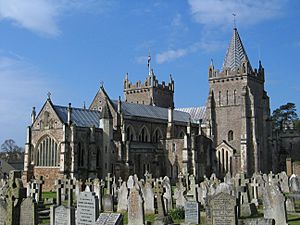
The parish church of St Mary's is often called "a miniature Exeter Cathedral". Like the cathedral, it has a cross shape. Its transepts (the arms of the cross) are formed by tall towers.
The church is 163 feet (50 meters) long, and its towers are 71 feet (22 meters) high. It was officially opened in 1260. At that time, the church belonged to Rouen Cathedral in France.
In 1335, John Grandisson, who was the Bishop of Exeter, bought the church. Two years later, he made it a collegiate foundation. This meant it had a group of clergy living and working together. Bishop Grandisson rebuilt much of the church. The main parts you see today, like the nave and chancel, are from this time.
The church is known for its painted ceiling. It also has a beautiful fan vaulted aisle from the early 1500s. This part, called the Dorset Aisle, was designed for Cecily Bonville, 7th Baroness Harington.
In 1850, the church was restored by an architect named William Butterfield. He made changes to make it more suitable for local church services.
The Ottery St Mary Astronomical Clock
The church is home to the Ottery St Mary Astronomical Clock. This is one of the oldest working mechanical clocks in the country. It is thought to have been made around 1350, during Bishop Grandisson's time.
The clock shows the Earth at the center of the solar system. This was how people understood the universe at that time.
Other Church Features
Inside the church, you can find ten misericords. These are small wooden seats that allowed monks to rest while standing during long services. Five of them show the coat of arms of Bishop John de Grandisson.
There are also two medieval carved stone "green men". These are faces made of leaves, often found in old churches. A small stone plaque remembers the poet Samuel Taylor Coleridge, who was born in Ottery in 1772. You can find it in the south churchyard wall.
The church also has tombs of Otho de Grandisson and his wife, an altar screen, and a wooden eagle.
Schools in Ottery St Mary
The town has two primary schools: West Hill Primary School and Ottery St Mary Primary School. West Hill Primary was founded in 1876 and has about 210 students. Ottery St Mary Primary has around 356 students.
The King's School is located on the edge of town. It was first started as a choir school by Bishop John Grandisson in 1335. Later, Henry VIII changed it into a grammar school in 1545. In 1982, it became a comprehensive school. Today, it is a Sports College with about 1,100 students and 80 teachers. It shares its sports facilities with the public.
Fun Local Traditions
Ottery St Mary is famous for its unique traditions.
The Tar Barrels Event
Every year around Guy Fawkes Night (November 5th), Ottery St Mary holds a special event called the Tar Barrels. This tradition dates back to the 1600s. Residents carry barrels soaked in tar through the town while they are on fire!
The event starts in the early evening with smaller barrels carried by children, then youths, and then women. The main event is when men carry 17 large barrels. These barrels can weigh up to 30 kg (66 pounds). They are lit outside each of the town's four pubs. The barrels are carried through the town center, which is often full of people. It's an exciting and risky sight!
Only people born in Ottery or who have lived there most of their lives can carry a barrel. Families have taken part in this tradition for many generations. Some believe the event started as a way to scare away evil spirits, similar to other fire festivals around Halloween.
In recent years, the event has faced challenges, like needing more insurance. But it still continues! The town's population of 7,000 grows to over 10,000 on this night. For safety, all roads into and out of Ottery are closed during the event.
In 2008, a bad hailstorm caused flooding in the town just before the event. But the community worked hard, and the Tar Barrels celebration still happened as planned. In 2009, there was an incident where an aerosol can exploded in a barrel, causing minor burns to some spectators. The event was cancelled in 2020 due to the Covid-19 pandemic.
Pixie Day: A Magical Legend
Pixie Day is an old tradition that happens every June. It remembers a legend about pixies being sent away from the town to local caves called the 'Pixie's Parlour'.
The legend says that long ago, a bishop wanted to build a church in Ottery. He ordered bells from Wales to be brought by monks. The pixies were worried because they knew the bells would end their rule over the land. So, they cast a spell on the monks. The spell made the monks walk towards a cliff edge at Sidmouth instead of Ottery.
Just as the monks were about to fall, one of them tripped and said, "God bless my soul!" This broke the spell. The bells were then brought to Ottery and put in the church.
However, the pixies' spell was not completely gone. Every year in June, 'pixies' (played by children) capture the town's bell ringers. They imprison them in a special Pixie's Parlour in the Town Square. The Vicar of Ottery St Mary then "rescues" them. The real Pixie's Parlour is a cave along the River Otter.
Old Ottregians Society
People from Ottery St Mary are called "Ottregians". In 1898, six young men from Ottery who lived in London decided to form a group. They wanted to create a society to bring Ottery people together, wherever they were. This was the start of the Old Ottregians Society. Their motto is Floreat Ottregia, which means "May Ottery Flourish". This society still exists today.
The Old Ottery Song
Another tradition in Ottery is the daily playing of the Old Ottery song. The church bells play the song at 8 AM, 12 PM (noon), and 4 PM every day. It is a tradition that funerals for Old Ottregians happen at noon, right after the song plays.
Here are the words to the song ('kine' means cattle):
Sweet-breathing kine, / The old grey Church, / The curfew tolling slow, / The glory of the Western Sky, / The warm red earth below. // O! Ottery dear! O! Ottery fair! My heart goes out to thee, Thou art my home, wher'er I roam, The West! The West for me!
John Coke's Ghost Story
Inside St Mary's Church, there is a colorful statue of a soldier named John Coke. The story says he was murdered by his younger brother in 1632. Because of this, people say his ghost sometimes steps down from the statue and walks around inside the church.
Ottery in the Media
Ottery St Mary was featured in an episode of the BBC radio comedy series Cabin Pressure.
Past Challenges and Disasters
Ottery St Mary has faced some difficult times in its history.
The Great Fire of 1866
On May 25, 1866, a huge fire broke out in Ottery. It started around noon and quickly spread through homes and shops. About a quarter of the town was destroyed, turning everything into ashes.
The fire began on Jesu Street. At first, people thought children playing with matches caused it. But later, it was found that a woman burning rubbish in her fireplace started it. The fire slowly burned through a wall to a school next door. It was discovered on the school's staircase around noon on Friday. Within hours, one hundred houses were destroyed, and 500 people lost their homes. This was 10% of the town's population at the time. A large part of the town became a pile of smoking ruins.
Aircraft Emergency Landing
In July 1980, a serious accident was avoided near Ottery. An aircraft was flying 62 passengers from Spain to Exeter Airport. It ran out of fuel about 11 miles (18 km) short of the runway. All four engines stopped working.
The pilot knew the area well. He was able to turn the plane and glide over the southern edge of the town. He made a safe crash-landing in a field near St Saviours' Bridge. The plane landed at 7:53 PM in daylight. The 27-year-old aircraft was badly damaged, but amazingly, the only casualties were two sheep.
An investigation found that the main cause was the crew thinking they had enough fuel. Problems with the fuel gauges and company instructions also played a part. However, the report praised the pilot's skill. His actions saved many lives, both on the plane and in the town. One of the plane's propellers was later given to the town to be sold for charity.
Ottery St Mary is still under the flight path for Exeter International Airport.
Historic Estates Nearby
There are several historic estates (large properties with land) in the Ottery parish:
- Cadhay
- Thorne
- Knightstone
Famous People from Ottery
Many notable people have connections to Ottery St Mary:
- Frederick Coleridge: A cricketer and clergyman.
- Samuel Taylor Coleridge: The famous Romantic poet was born here on October 21, 1772. His father was the vicar and headmaster of King's School, and the family lived at The Chanter's House.
- Edward Davy: An English doctor, scientist, and inventor, born in Ottery.
- Sir Ernest Satow: A diplomat who lived in Ottery after he retired (1906–1929). He is buried in the churchyard.
- Hugh Whitby: A cricketer and schoolmaster.
- Claire Wright: A politician.
- Stuart Hogg: The Scottish rugby union captain lives in the town.
Sports and Fun Activities
The local Non-League football club, Ottery St Mary A.F.C., plays at Washbrook Meadows.
The Colin Tooze Sports Centre is located across from the King's School. There is also the Move Forward Gym in Finnimore Trading Estate.
From 1968 to 1974, Ottery had a folk club. It met every week at the London Inn and featured local singers and other artists.
Getting Around Ottery
Until 1967, Ottery St Mary had its own Ottery St Mary railway station. The railway line connected to Sidmouth Junction (now Feniton) and went to Sidmouth and Exmouth. The station closed as part of the Beeching Axe plan to cut railway lines.
For many years, you could still see where the railway used to be. The closest railway station to Ottery St Mary now is Feniton, about 3 miles (5 km) away.
Twin Towns
Ottery St Mary has two twin towns:
- Pont-l'Évêque, France (since 1977)
- Ilsfeld, Germany (since 2003)
See also
 In Spanish: Ottery St Mary para niños
In Spanish: Ottery St Mary para niños


